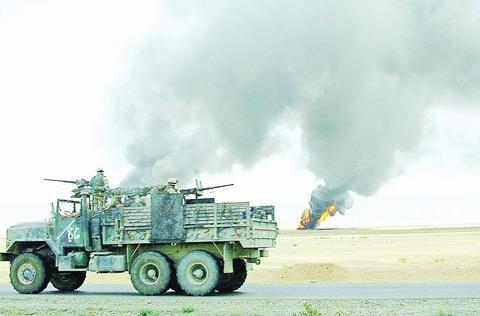Oil prices fell nearly 4 percent on Friday after the International Energy Agency said big consuming countries were more comfortably supplied than it previously thought.
US light crude tumbled US$1.18 to US$30.33 a barrel, extending Thursday's sharp losses and pulling prices back from recent 12-week highs above US$32. London August Brent crude fell US$0.87 to US$26.35 a barrel.

PHOTO: AFP
Prices fell as the Paris-based IEA, energy adviser to 26 industrialized nations, said its previous estimate of oil stock levels was 79 million barrels too low.
The agency's revised estimate put oil stocks in the industrialized world for the end of April at 2.439 billion barrels,
"Stocks are still below normal and can absorb some surplus in the third quarter, but I think we have entered a stage when more supply is coming on the market and will impact prices," said Geoff Pyne, oil market consultant to Sempra Energy Trading.
The IEA said the revision did not change its view that global markets were tight. Stocks are still 157 million barrels, or 6.5 percent, below last year.
"The market is obviously better supplied than we thought as little as two weeks ago, but stocks are still low and fundamentals are still tight, so we need to build more stocks," said Klaus Rehaag, editor of the IEA monthly oil market report.
"The increase in crude stocks may, however, signal some relief for an otherwise tighter heating oil situation later this year," he added
Oil stocks have been drawn down this year by a harsh northern winter and supply disruptions from a strike in Venezuela, ethnic strife in Nigeria and the war in Iraq.
Iraq on Thursday sold its first oil since the US-led invasion nearly three months ago, but looting and sabotage at oil facilities are expected to keep Iraq's exports well below prewar levels for several months.
The delays in Iraq's postwar export resumption enabled the OPEC producer cartel to postpone fresh supply cuts at Wednesday's meeting in Qatar.
OPEC, which controls about half the world's oil exports, decided to meet again in just seven weeks, on July 31, in case the return of Iraqi shipments undermines high prices.
OPEC sets a US$22 to US$28 target range for its basket of seven grades of crude oil. The basket was last valued at US$27.48.

Taiwan Semiconductor Manufacturing Co (TSMC, 台積電) last week recorded an increase in the number of shareholders to the highest in almost eight months, despite its share price falling 3.38 percent from the previous week, Taiwan Stock Exchange data released on Saturday showed. As of Friday, TSMC had 1.88 million shareholders, the most since the week of April 25 and an increase of 31,870 from the previous week, the data showed. The number of shareholders jumped despite a drop of NT$50 (US$1.59), or 3.38 percent, in TSMC’s share price from a week earlier to NT$1,430, as investors took profits from their earlier gains

In a high-security Shenzhen laboratory, Chinese scientists have built what Washington has spent years trying to prevent: a prototype of a machine capable of producing the cutting-edge semiconductor chips that power artificial intelligence (AI), smartphones and weapons central to Western military dominance, Reuters has learned. Completed early this year and undergoing testing, the prototype fills nearly an entire factory floor. It was built by a team of former engineers from Dutch semiconductor giant ASML who reverse-engineered the company’s extreme ultraviolet lithography (EUV) machines, according to two people with knowledge of the project. EUV machines sit at the heart of a technological Cold

Taiwan’s long-term economic competitiveness will hinge not only on national champions like Taiwan Semiconductor Manufacturing Co. (TSMC, 台積電) but also on the widespread adoption of artificial intelligence (AI) and other emerging technologies, a US-based scholar has said. At a lecture in Taipei on Tuesday, Jeffrey Ding, assistant professor of political science at the George Washington University and author of "Technology and the Rise of Great Powers," argued that historical experience shows that general-purpose technologies (GPTs) — such as electricity, computers and now AI — shape long-term economic advantages through their diffusion across the broader economy. "What really matters is not who pioneers

TAIWAN VALUE CHAIN: Foxtron is to fully own Luxgen following the transaction and it plans to launch a new electric model, the Foxtron Bria, in Taiwan next year Yulon Motor Co (裕隆汽車) yesterday said that its board of directors approved the disposal of its electric vehicle (EV) unit, Luxgen Motor Co (納智捷汽車), to Foxtron Vehicle Technologies Co (鴻華先進) for NT$787.6 million (US$24.98 million). Foxtron, a half-half joint venture between Yulon affiliate Hua-Chuang Automobile Information Technical Center Co (華創車電) and Hon Hai Precision Industry Co (鴻海精密), expects to wrap up the deal in the first quarter of next year. Foxtron would fully own Luxgen following the transaction, including five car distributing companies, outlets and all employees. The deal is subject to the approval of the Fair Trade Commission, Foxtron said. “Foxtron will be